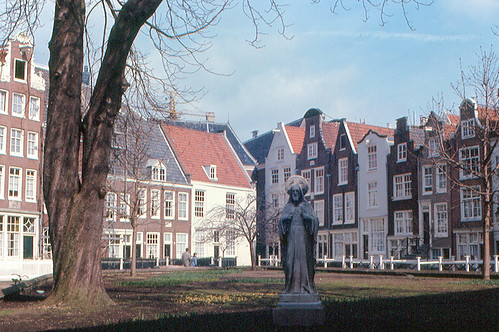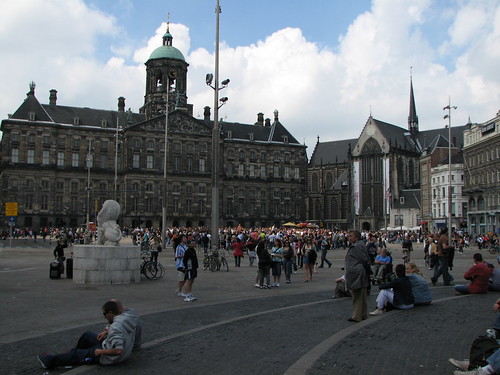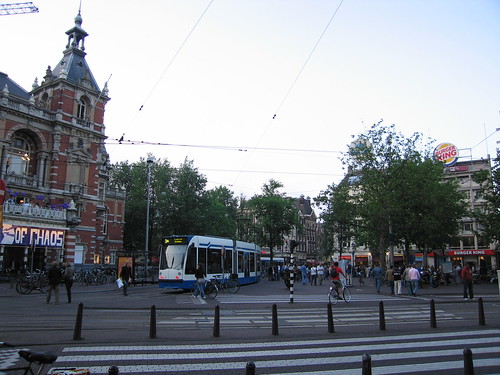What to see in Amsterdam? – Part III
We are still in Amsterdam and although we have seen a lot of things we still here to stay. In Part 1 we had what to see in Amsterdam and its surroundings. In Part 2 you could read what some of the most interesting museums and churches of the Dutch capital.

Photography by roger4336
After the Reformation, Amsterdam became a Protestant city in which public Catholic worship was forbidden. This encouraged the craftiness of the Catholics who continued to practice in underground churches. In 1661 Jan Hartman, a wealthy Catholic merchant, gave his house to the Catholic community to build one of these churches. Thus there is the Church of Our Lady of the Attic (Ons’ Lieve Heer op Solder). In this curious place parishioners entered through a door in the side alley and up a narrow staircase to access the hidden church on the third floor.
Staircase to the Church of Our Lady of the Attic:
The capacity is 150 people and during the visit, the church hid the kitchen are also available, the confessional and some other rooms where religious displays objects. Unfortunately what was going to be a special visit turned into disappointment as they were for reform. In return we get a reduced price.
Chapel and High Altar (under construction) This was the second clandestine church in Amsterdam next to the Church of St. John and St. Ursula in the Begijnhof. In 1671, architect Philip Vingboons took two houses and turned them into a Catholic church. This temple was hidden in enforcement Calvinists and from outside could not be recognized as something outside the law. El Barrio Begijnhof is a rarity in the city. It is an inner courtyard free of noise that was built during the Middle Ages. So much so that the entrance is a sign that requests to remain silent to maintain the tranquility of the place.

Photography by jylcat
Begijnhof The neighborhood’s name comes from their old neighbors. Beghine were single women who professed the Catholic religion and did good works as the nuns but not wanting to live imprisoned in a convent not take votes. While the initial Begijnhof XIV century, successive fires, renovations and expansions have made the current patio is the seventeenth and eighteenth centuries, although the number 34, «Houten Huys» is 1528.
Despite the advance of modernity Amsterdam retains many historic sites around the center is a good example of this. Not far from the church hidden in the attic is the Plaza Nieuwmarkt (New Market) in the center stands a castle gates and towers known as De Waag, the home of weight, an institution that served to weigh the goods that traders brought to the city. The building was the old gate of San Antonio who lost their defensive function when Amsterdam demolished medieval walls in the fifteenth century. This building has been used also as guild house as diverse as builders, painters and surgeons. The doctors came to mount a theater where they performed public dissections. Today it is a cafe with a long history.
The Waag Nieuwmarkt always people around you accumulate many entertainment venues and the oldest pharmacy in Amsterdam, Jacob hooey, a business that has been open since 1749. Since we are here is worth mentioning that the plaza is home to two street markets are one of the main attractions. If we drop on Saturday we can enjoy the organic market and on Sundays from May to October to take home some antique. Besides Nieuwmarkt in Amsterdam have a place other markets like consumer needs. The biggest of all is Albert Cuyp more than a mile long. In its 300 stalls you can find absolutely everything. In 2005 celebrated 100 years. Watterlooplein market is attracting more tourists. Variety is the main feature but is famous for its secondhand goods from clothes to music CDs. Another place for shopaholics Dappermarkt is recognized by National Geographic as one of the top 10 street markets in the world. Finally, if our agriculture is we can not ignore the Bloemenmarkt, the flower market. A stretch of the Amstel River that contains fifteen florists located on barges.

Photography by Ariaski
Bloemenmarkt on the right bank of the River Amstel:
Florist Bloemenmarkt And with that we end up today. Since we have little to go, so if you’ve got here sure you take a step forward …
In the first article of this series discussed how to get to Amsterdam and its nerve center, the Dam Square The second half was more cultural and talk of museums and churches not to mention one of its greatest historical sites, the Anne Frank House. In the third part we saw some of the consequences of the Protestant Reformation and visited some of the street markets in Amsterdam. Now is the turn of Chinatown and the popular neighborhood of the capital, can you guess what?.

Photography by james.
Tours in Amsterdam:
Begin the journey in one of the places we visited in the previous article Nieuwmarkt Square. Behind the Casa del Peso, The Waag, a street that goes directly introduces us to Chinatown in Amsterdam. By size is far less comparable to Canal Street in New York but has its charm. On the street Zeedijk a building stands above the rest, this is the For Guang Shan Buddhist temple He Hua. Entrance is free but the truth is not much to see inside, yes, perhaps you will join me in asking that their cause as an excuse to bring out the rooms.
Temple For Guang Shan He Hua:
The rest of Chinatown is just another pair of saturated streets of restaurants and strange smells that, personally, not at all like something that is edible.
And finally we arrived at the time the guys were waiting more viciosillos. Chinatown crossed in just three minutes to reach the Red Light District (Red Light District), by far the most visited area of Amsterdam. For the few who still do not know prostitution is regulated in the Netherlands still legal under certain circumstances. Prostitutes as workers are forced to hire health insurance and pay taxes to the state. In the seventeenth century to sell showcases best start to appear in this area so they offered their services from the window of his home.
Red Light District:
The «show» to see them displayed in windows is something that strikes at first sight. Server is quite liberal and even though I knew that was the subject did not stop surprising me, I even felt some discomfort. The Red Light District is located in the heart of Amsterdam within walking distance from Dam Square and drugs and prostitution have never been more apparent. It is true that this is not unique to Amsterdam as there are coffee shops across the country and booths in eight other cities, although the number remains controlled by law.

Photography by AMagill
Red Light District:
The Red Light District also has numerous pubs, sex shops and erotic entertainment venues make it an enormous temptation sinful open 24 hours a day. Yes, in his morning walk with women are offering their services are not surprised. The street that focuses more premises is Warmoestraat although abundant and all is normal here.
The condom store:
I feel this party is not rich in photographs but you know that taking the camera is frowned upon and kept in its case is an unwritten law which should be respected. Depending on which site you can find you a man that very large and very unfriendly to you the start of the hand. So no pictures of the «windows.»
Finally we will try the other major «industry» of the city, the legal sale and consumption of cannabis (marijuana, grass, or as you please call). Although not exclusive to Amsterdam, as permitted by law throughout the country, the concentration of coffee shops is especially high here because of the influx of visitors. These places can serve drinks and food like any normal bar but with the peculiarity that the sale of alcohol or other drugs is prohibited.

Photography by vitalyzator
Bon Voyage!
Leave a Reply
You must be logged in to post a comment.
Recent Comments